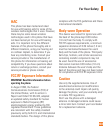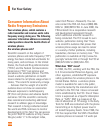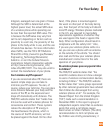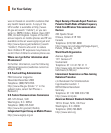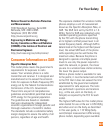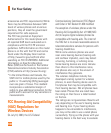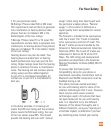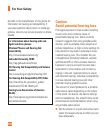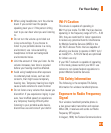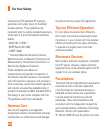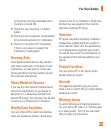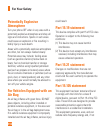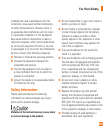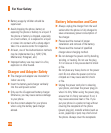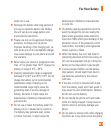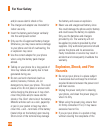
111
For Your Safety
When using headphones, turn the volume
down if you cannot hear the people
speaking near you or if the person sitting
next to you can hear what you are listening
to.
Do not turn the volume up to block out
noisy surroundings. If you choose to
listen to your portable device in a noisy
environment, use noise-cancelling
headphones to block out background
environmental noise.
Limit the amount of time you listen. As the
volume increases, less time is required
before your hearing could be affected.
Avoid using headphones after exposure
to extremely loud noises, such as rock
concerts, that might cause temporary
hearing loss. Temporary hearing loss might
cause unsafe volumes to sound normal.
Do not listen at any volume that causes you
discomfort. If you experience ringing in your
ears, hear muffled speech or experience
any temporary hearing difficulty after
listening to your portable audio device,
discontinue use and consult your doctor.
Wi-Fi Caution
This device is capable of operating in
802.11a/n/ac mode. For 802.11a/n/ac devices
operating in the frequency range of 5.15 – 5.25
GHz, they are restricted for indoor operations
to reduce any potential harmful interference
for Mobile Satellite Services (MSS) in the
US. Wi-Fi Access Points that are capable of
allowing your device to operate in 802.11a/n/
ac mode(5.15 – 5.25 GHz band) are optimized
for indoor use only.
If your Wi-Fi network is capable of operating
in this mode, please restrict your Wi-Fi use
indoors to not violate federal regulations to
protect Mobile Satellite Services.
TIA Safety Information
The following is the complete TIA Safety
Information for wireless handheld phones.
Exposure to Radio Frequency
Signal
Your wireless handheld portable phone is
a low power radio transmitter and receiver.
When ON, it receives and sends out Radio
Frequency (RF) signals.
In August, 1996, the Federal Communications



